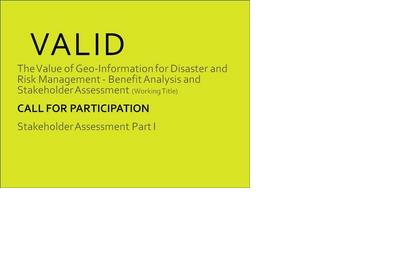The results of the first stakeholder assessment of the VALID project are now available on the Knowledge Portal. The project is carried out by UN-SPIDER and the Joint Board of Geospatial Information Societies (JBGIS). The goal of VALID (The Value of Geo Information for Disaster and Risk Management) is to raise awareness regarding the potential of geospatial technologies for disaster and risk management to deciders in governmental and administrative bodies, to disaster management professionals and to other stakeholders. The intention is to give evidence of the economic, humanitarian, operational and organizational benefit of geo information. The overall results are envisaged to be published as a booklet in summer 2013. The results of the first stakeholder assessment are also available in an article entitled "Applying Geoinformation to Disaster and Risk Management: Impact and Benefits" published in Directions Magazine in September 2012.
The expected outcome of VALID is a differentiated, scientifically founded answer to the crucial question: What is the difference you can make with geoinformation? The approach is two-fold in order to ensure a holistic view on the benefits of geoinformation for disaster management and best possible coverage of the disaster management cycle. In a classical cost-benefit analysis the costs of an investment are compared with the monetary value of societal and economic benefits they generate. While the costs of a given geoinformation product can be easily estimated by any provider, monetizing its societal benefit is more complicated and fuzzy. A comprehensive literature review provides a global overview on the economic losses and impacts caused by disasters. The available body of literature is to be scanned for evaluations and recommendations (e.g. regarding the potential of risk reduction and preparedness), resulting in a set of needs profiles, which would address aspects of organization, information and infrastructure. A comprehensive literature database has been set up. The ongoing analytical work is complemented by a dedicated case study on the Namibian flood in spring 2009. The expected outcome will highlight benefits as well as shortcomings and needs, and specify effects of physical, societal and organizational boundary conditions.
The VALID project is a follow-up on the booklet "Geoinformation for Disaster and Risk Management - Examples and Best Practices" which was officially launched during the Centenary Congress of the International Society for Photogrammetry and Remote Sensing (ISPRS) in Vienna on July 2, 2010. For this publication, JBGIS and UN-SPIDER jointly invited the global stakeholder community to contribute articles for a collection of case studies, application examples and best practices. They received and evaluated more than 70 responses, finally taking into account 16 of them. It convincingly demonstrates various aspects of geospatial technology and how that technology can be efficiently integrated into risk and disaster management. More information is available from the ISPRS website

